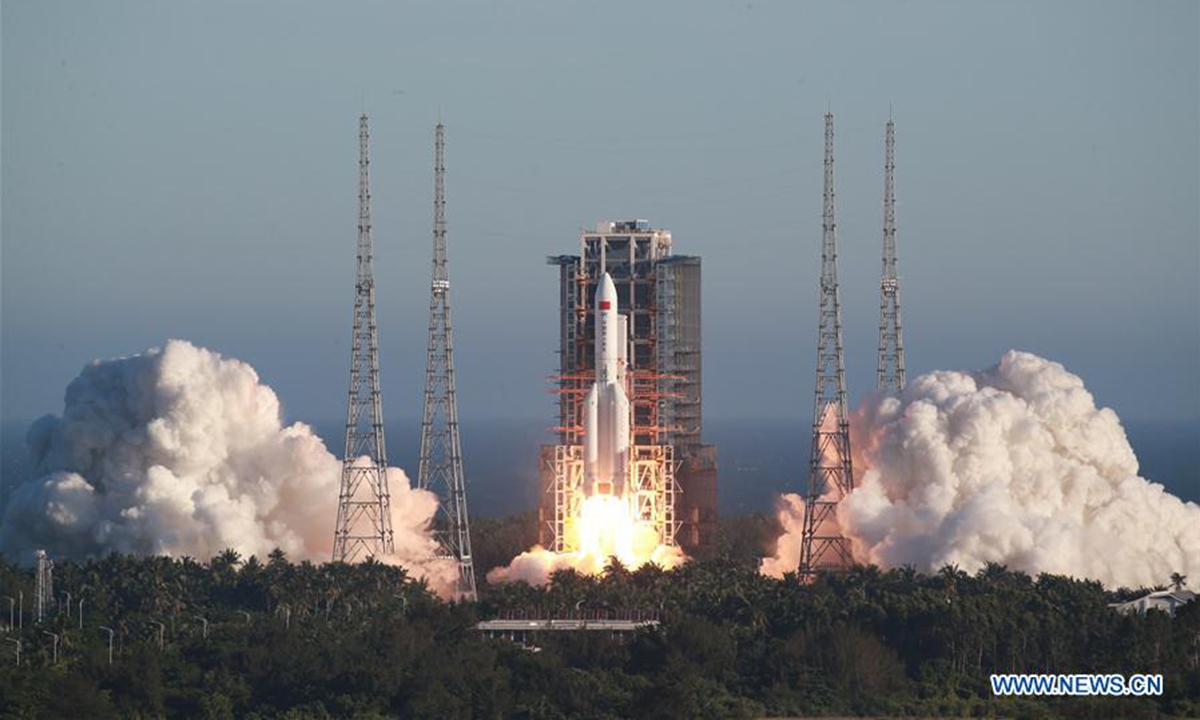
China's new large carrier rocket Long March-5B blasts off from Wenchang Space Launch Center in south China's Hainan Province, May 5, 2020. China's new large carrier rocket Long March-5B made its maiden flight Tuesday, sending the trial version of China's new-generation manned spaceship and a cargo return capsule for test into space. (Photo by Tu Haichao/Xinhua)
The US' fussiness over China's Long March-5B debris' re-entry, fully displayed in Western media reports that spared no effort in painting a "catastrophic aftermath," has mounted to a new high as NASA's newly appointed chief Bill Nelson openly criticized China's "lack of transparency" and "failure to act responsibly" over the event.
However, the fact that the re-entry of rocket remnants on Sunday has turned out to be harmless alone soundly refuted their low ploy against China, and developers of the Long March-5B from China's largest rocket manufacturer the China Academy of Launch Vehicle (CALT) have also shared some insights with the Global Times on Monday, pointing at the double standards shown in the comments left by some US politicians and individuals.
Normally, debris of those carrier rockets that do not have to fly at a high altitude would soon fall back to earth, and rocket designers would precisely predict the landing area before launch, to ensure it would cause no damage or harm, said Zhang Borong, a CALT rocket designer.
However, in some carrier rockets, whose flight altitudes have entered space and reached low Earth orbit, their speed would reduce as the result of friction with the edge of atmosphere and so would their altitude to a point back into the atmosphere, Zhang noted.
The Long March 5B Y2, whose mission was to send a core module of China's space station into orbit, falls into the category. "Their re-entry speed would be so huge that they would be burned to destruction in their friction with the atmosphere, rather than smash on Earth as in those sci-fi movies," the CALT expert said.
In the past few days the Chinese Foreign Ministry has repeatedly cited the country's space authorities by saying that the Long March-5B Y2 rocket adopted passivation technology that would not cause any explosion during orbit and the dispersion of debris in space.
Such passivation technology is to discharge the remaining fuel and high pressure gas from the rocket body, and cut the battery onboard to eliminate the risk of an explosion of the upper stage, Zhang explained.
Despite clarification by China's space industry insiders and the Foreign Ministry that the probability of the rocket remnants causing harm was extremely low, a number of Western media outlets, including CNN and The New York Times, as well as the Pentagon and NASA, claimed the debris was heading back to Earth in an "uncontrolled" manner and criticized China for being "irresponsible" for the ocean landing.
Zhang noted that it is not true that such re-entry of the rocket debris is unpredictable in terms of its landing location, rather the impossibility lies in a precise prediction, as it could be impacted by many factors, including the delicate change in pneumatic environment.
"No country has the capability to precisely predict the shape, size, or quantity of such rocket debris, or the landing range of such debris," the expert said.
The odds of getting hit by a falling rocket should be lower than that of getting hit by a meteorite or that of getting struck by lightning, he added.
Space analysts reached by the Global Times on Monday said that there have been no predictions of the landing more accurate than Chinese space authorities have offered, and China has shared the solution in advance.
China conducted close monitoring and tracking work throughout the re-entry of the Long March-5B Y2 carrier rocket remnants on Sunday, and had shared a relevant forecast via international cooperation mechanisms, the Chinese Foreign Ministry spokesperson said on Monday.
There have been no reports of ground damage caused by the re-entry, Hua told the media on Thursday, citing the Chinese Manned Space Agency and the China National Space Administration, emphasizing that it is a common practice around the world for launch vehicles to undergo a natural attenuation of orbital altitude and eventually enter the atmosphere for destruction.
Hua also criticized some US media and certain individuals for their double standards in dealing with the issue. "We can recall when a US rocket stage re-entered in March at a local farmer's property, the US media described the scene with rather romantic vocabulary such as 'comet-like trails.'"
But it is another story when it comes to Chinese rockets and China, Hua said. "Some Chinese netizens joked that some US politicians might be forgetful, but the internet remembers. We are willing to work with other countries including the US in the peaceful use of outer space, but we oppose holding a double standard over the matter," she said.

